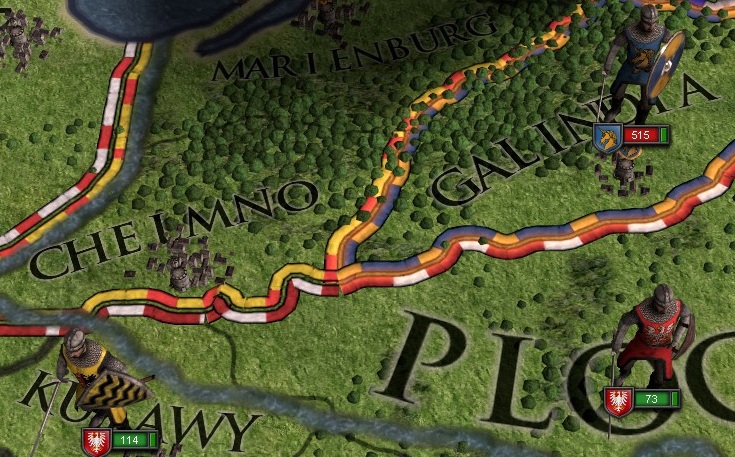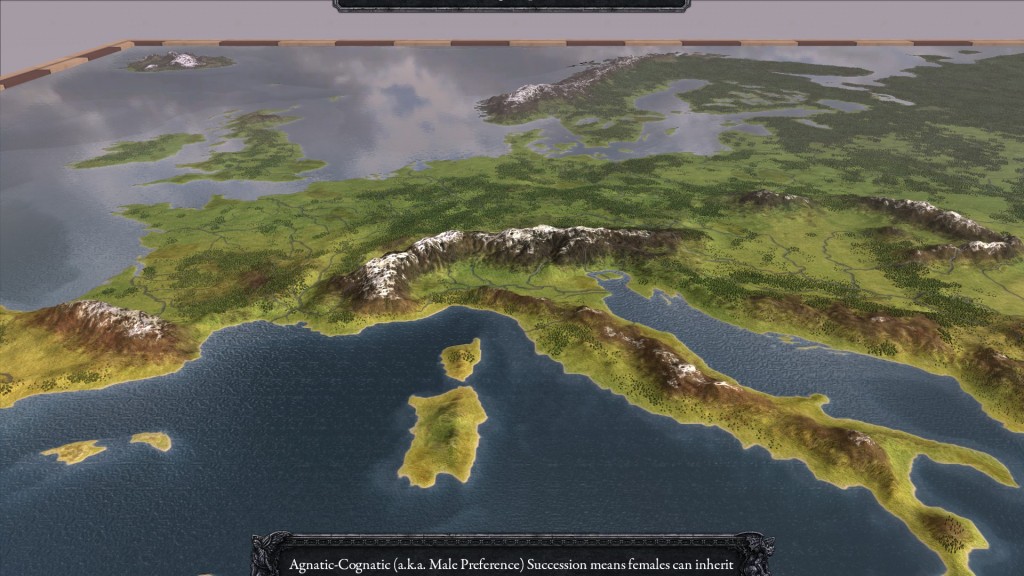- Guest post: One hour with Crusader Kings II, by Rachel McFadden
- Crusader Kings II: Feudalism: domain thing?
- How to lose Crusader Kings II: a very short guide
- On the importance of swooshing cameras (or, personal meanderings how minor details add up to significant effect)
- Crusader Kings II: The Old Gods, As Told in Classified Ads
Europa Universalis II was my first Paradox game. Since then I’ve played every strategy title Paradox has produced, excepting the Hearts of Iron series. Whilst I have great respect for their scope and ambition, and do not care to think about how many hours of my life they have consumed, I have often found them rather soulless. Not quite the proverbial Excel spreadsheet – but not all that far off. They lacked atmosphere and felt like they had little to do with the era they portrayed outside of a handful of specific game mechanics and some window dressing. After a lengthy process of gradual improvement, I find that Crusader Kings II demonstrates that Paradox has put the final nail in that soulless feeling’s coffin.
How have the developers managed this? With a swooshing camera, trivial artwork, nicely timed music, and a few other entirely frivolous details which, taken together, add up most pleasingly.
When Crusader Kings II launches, it greets the player with a stained-glass version of the Paradox company logo. This is not unusual: the other games all feature a customised version of the logo. The intro music begins to play immediately, a gentle piece with soft chanting over the top of a small selection of instruments. If you do not own the game, you can listen to the title music here. The logo swaps to a slideshow of unique illustrations. After 52 seconds, the point where the game will transition to main menu on most computers, the music begins to pick up both in pace and in complexity. At 1:03, bam! The music temporarily kicks up another level as the player surveys their options, then goes softer to permit undistracted thought. At 2:06, around the time I’m seriously pondering the merits of a particular dynasty, the music kicks up to full fever and my head fills with visions of epic conquest. Whether the harmony of game timing and music pace is intentional or a happy accident, the sequence does possess a few advantages over Paradox’s prior games. The two immediately prior handily demonstrate two different approaches, neither of which I feel works as well. Sengoku observes total silence through the loading screens; music makes its first appearance when the player arrives at the main menu. A House Divided, the expansion pack for Victoria II, has an animated intro sequence prior to the loading screens. Whilst this works nicely on the player’s first game, on all subsequent ones it is skipped. This results in a burst of disassociated music before the video vanishes and the majestic loading screen music begins. Compared to Crusader Kings II’s smooth sequence, the result feels uneven and disrupted.
Crusader Kings II has another trick up its sleeve for the opening: my titular swooshy camera. The main menu is a 3D map of Christendom plus neighbouring non-Christian lands. Click on ‘single player’ and swoosh! The camera swings in, seamlessly transitioning the map from background to the centrepiece on which you choose your dynasty. Choose your dynasty and start the game, and swoosh! Once again, a seamless transition as the map zooms in on your starting location, the interface swaps to the in-game set, and the game is ready to play. As Nintendo 64 owners used to tell their Playstation ‘rivals’ during the fifth-generation console wars, smooth transitions and no loading times matter. In this instance they preserve the atmosphere the game creates, and allow for one very neat visual effect. The swoosh itself, despite being a tiny bit of programming, makes the game feel more luxurious than previous Paradox titles. It feels like a Big Boy Studio effect.
The swooshy camera also reveals an overt secret. When the camera begins its first swoop, you can see the boundaries of the 3D world. Rather than cutting off in an ugly crop, there is a raised, patterned wooden border. The world exists as a sculpture inside a tray. Who would possess such a map? How about the fabled Emperor Qin, whose tomb is said to possess a map of China with rivers made out of mercury. Plush! Crusader Kings II is not the first game to present its map as precisely that. Victoria II mimicked a school atlas when the player zoomed out far enough, and CA’s original Shogun: Total War plays out on a parchment map with carved wooden counters, to name but two. That said, the effect is unusual, and presented in a manner which feels distinct to this one game.
What about the sound effects? Where most games feature bland clicking sounds when you hit this or that interface button, Crusader Kings II features various harp chords. Move around quickly enough and you create your own little tune. This only applies to the ‘choose your dynasty’ screen, so it does not have the chance to wear out its welcome.
That’s the swooshy camerawork and the well-timed music. What about the rest?
As a casual glance at any screenshot will reveal, the game’s interface is a concoction of stained-glass, occasional gilding, muted colours, and niello. In-game, you will notice a multitude of little details, like sections of scrollwork carving. The stained-glass buttons are made up of numerous little panes, not crude chunks of colour. Messages are presented on scraps of tattered parchment. There’s a large variety of custom paintings used across the interface, from the reclining lady in the pregnancy announcement to the soldiers on the battle screen. This is an image-rich game. I cannot think of any other Paradox game with as many supporting artworks. In this aspect Crusader Kings II is once again the culmination of a slow process; each Paradox game has added a little more care to the UI artwork, passing from the functional ugliness of the early games, through the passable but bland games like Victoria, to the almost-but-not-quite of Sengoku‘s tasteful wooden panelling.
Having given a nod to the most obvious, I’d like to move to the minor detail I myself find most important: armies. In prior games, armies tended to look very similar, to the point where I occasionally found it difficult to tell who owned what! Crusader Kings II gives each province’s army its own unique coat of arms, and an army levied from that province will wear the coat of arms on its surcoat. Additionally, different cultures have different army models. Instantly, the world feels far more alive, the game more detailed. Now that sounds confusing in the opposite direction. How do you tell which army belongs to whom? Answer: it’s easy to recognise the coats of arms, yours and your foes’, because you see them all the time whilst playing the game. Heraldry works – that’s why it was used for so many centuries. If that’s not enough, the owning faction’s icon appears below the army model, and it’s that vital bit bigger and clearer than similar identifiers in games like Sengoku, whilst not so disassociated as the big flags in games like Europa Universalis III.


The characters speak for themselves. Instead of being filled with rather bland countries differentiated only by their flag, Crusader Kings II has a world filled with varied faces, traits and statistics. This is the evolution of a design which began in Crusader Kings I, then grew in Europa Universalis: Rome and Sengoku. Whilst the range of character stats and actions is a little larger, it is once again the seemingly unnecessary frippery which helps Crusader Kings II take that leap ahead. Due to a wider range of character portraits, improved visual detail on those portraits, and a better visual aging process, the game feels that bit more convincing. That in turn supports the character-based gameplay, with all its inter-personal relationships and event choices. In a satisfying loop, that gameplay bolsters the portraits by making the faces feel like more than a randomised bit of art.
A swooshy camera, lots of minor graphical frippery, a few frivolous details – all unnecessary fanciness with little relation to gameplay… all vital to making Crusader Kings II feel alive.
Rachel McFadden (aka frogbeastegg) has been gaming since she discovered the original Prince of Persia on the IBM 286sx PC. Whilst strategy and RPGs are her preferred genres, she is a multiplatform gamer who will play almost anything provided it isn’t sport, car racing, or multiplayer only. Under the frogbeastegg name Rachel has written guides for many of the Total War series, various AARs for strategy games, and a few pieces of fiction. When not engaged in reminding various virtual populaces that she is in fact the Supreme Ruler of the Universe and the One True Hero, Rachel can typically be found with her nose in a book.
Note: the above comments are based on a review copy supplied by the game’s developer, Paradox Interactive.


Heya! I’d sure like to see some more CKII write-ups hereabouts!
Keep up the good work.